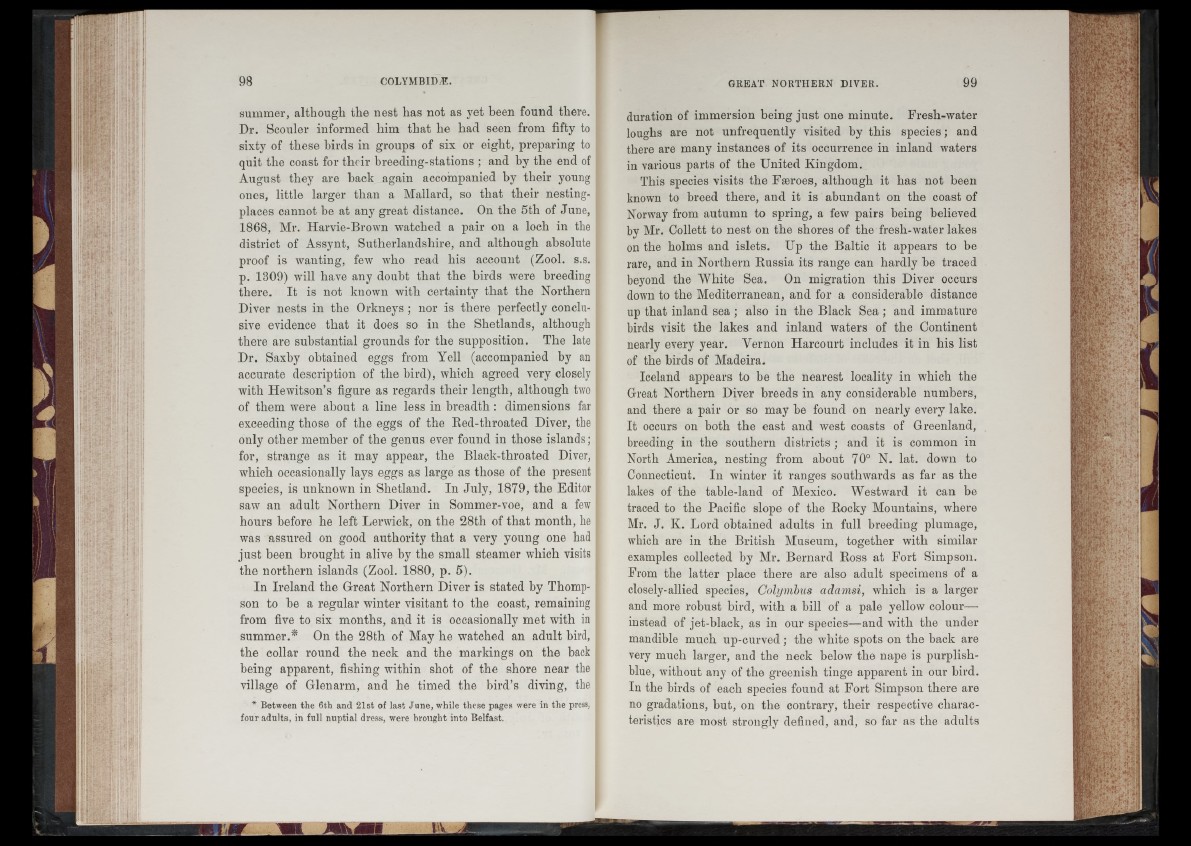
summer, although the nest has not as yet been found there.
Dr. Scouler informed him that he had seen from fifty to
sixty of these birds in groups of six or eight, preparing to
quit the coast for their breeding-stations ; and by the end of
August they are hack again accompanied by their young
ones, little larger than a Mallard, so that their nesting-
places cannot he at any great distance. On the 5th of June,
1868, Mr. Harvie-Brown watched a pair on a loch in the
district of Assynt, Sutherlandsliire, and although absolute
proof is wanting, few who read his account (Zool. s.s.
p. 1309) will have any doubt that the birds were breeding
there. It is not known with certainty that the Northern
Diver nests in the Orkneys ; nor is there perfectly conclusive
evidence that it does so in the Shetlands, although
there are substantial grounds for the supposition. The late
Dr. Saxby obtained eggs from Yell (accompanied by an
accurate description of the bird), which agreed very closely
with Hewitson’s figure as regards their length, although two
of them were about a line less in breadth : dimensions far
exceeding those of the eggs of the Red-throated Diver, the
only other member of the genus ever found in those islands;
for, strange as it may appear, the Black-throated Diver,
which occasionally lays eggs as large as those of the present
species, is unknown in Shetland. In July, 1879, the Editor
saw an adult Northern Diver in Sommer-voe, and a few
hours before he left Lerwick, on the 28th of that month, he
was assured on good authority that a very young one had
just been brought in alive by the small steamer which visits
the northern islands (Zool. 1880, p. 5).
In Ireland the Great Northern Diver is stated by Thompson
to be a regular winter visitant to the coast, remaining
from five to six months, and it is occasionally met with in
summer.* On the 28th of May he watched an adult bird,
the collar round the neck and the markings on the back
being apparent, fishing within shot of the shore near the
village of Glenarm, and he timed the bird’s diving, the
* Between the 6th and 21st of last June, while these pages were in the press,
four adults, in full nuptial dress, were brought into Belfast.
duration of immersion being just one minute. Fresli-water
loughs are not unfrequently visited by this species; and
there are many instances of its occurrence in inland waters
in various parts of the United Kingdom.
This species visits the Faeroes, although it has not been
known to breed there, and it is abundant on the coast of
Norway from autumn to spring, a few pairs being believed
by Mr. Collett to nest on the shores of the fresh-water lakes
on the holms and islets. Up the Baltic it appears to be
rare, and in Northern Russia its range can hardly be traced
beyond the White Sea. On migration this Diver occurs
down to the Mediterranean, and for a considerable distance
up that inland sea ; also in the Black Sea ; and immature
birds visit the lakes and inland waters of the Continent
nearly every year. Vernon Harcourt includes it in his list
of the birds of Madeira.
Iceland appears to be the nearest locality in which the
Great Northern Diver breeds in any considerable numbers,
and there a pair or so may be found on nearly every lake.
It occurs on both the east and west coasts of Greenland,
breeding in the southern districts ; and it is common in
North America, nesting from about 70° N. lat. down to
Connecticut. In winter it ranges southwards as far as the
lakes of the table-land of Mexico. Westward it can be
traced to the Pacific slope of the Rocky Mountains, where
Mr. J. K. Lord obtained adults in full breeding plumage,
which are in the British Museum, together with similar
examples collected by Mr. Bernard Ross at Fort Simpson.
From the latter place there are also adult specimens of a
closely-allied species, Colymbus adamsi, which is a larger
and more robust bird, with a hill of a pale yellow colour—
instead of jet-black, as in our species—and with the under
mandible much up-curved; the white spots on the back are
very much larger, and the neck below the nape is purplish-
blue, without any of the greenish tinge apparent in our bird.
In the birds of each species found at Fort Simpson there are
no gradations, but, on the contrary, their respective characteristics
are most strongly defined, and, so far as the adults